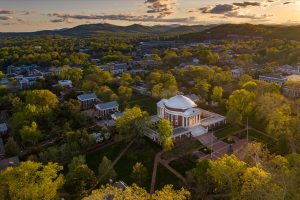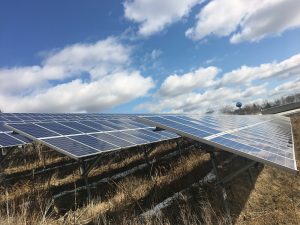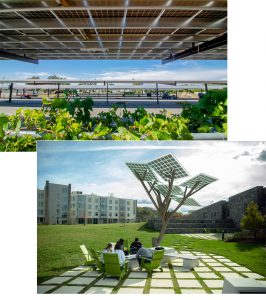The United States spends $400 billion every year to power buildings and industrial facilities. On average, 20 to 30% of this energy is wasted.¹ Reducing greenhouse gas (GHG) emissions presents opportunities not only to increase energy efficiency, but also to cut costs, create jobs, strengthen global competitiveness, and mitigate climate change. For the United States to reach a net-zero emissions economy by 2050, buildings and manufacturing plants must drastically cut GHG emissions within this decade. As it stands now, more than 60% of U.S. GHG emissions derive from residential, commercial, and industrial facilities.²
Market leaders understand the need to act. Technology companies, local governments, industrial manufacturers, schools, retailers, health care systems, and many others have set targets to reduce GHG emissions. In fact, as of 2020, 60% of Fortune 500 companies had made at least one climate commitment.³
However, setting emissions targets is only the first step. Taking action—specifically, identifying and implementing proven pathways to decarbonization—is where organizations now need to focus and succeed.
Real Pathways to Cutting Emissions: DOE’s Better Climate Challenge
In early 2022, the U.S. Department of Energy (DOE) launched the Better Climate Challenge (BCC) to respond to the need for the public and private sectors to work together to demonstrate real-world pathways to decarbonizing our buildings, homes, and industrial facilities. This national partnership calls on organizations across the country to set ambitious GHG reduction targets and share their successful solutions with the broader market.
Organizations that join with DOE in the BCC commit to reducing their GHG emissions (Scope 1 and 2) across their facilities and fleets by at least 50% within ten years without the use of offsets. Partners also agree to share their pathways, work with their peers, and help DOE understand the barriers to decarbonization. DOE provides technical assistance and convenes peer-to-peer exchanges to facilitate collaboration – a necessary ingredient for rapid, economy-wide decarbonization.
The potential impact is significant: If all organizations in the commercial, public, and industrial sectors reduced their U.S. GHG emissions by 50%, it would save nearly 1.5 billion metric tons of CO2e annually4—more than the emissions from every U.S. home.
When DOE launched the BCC, U.S. Secretary of Energy Jennifer M. Granholm framed the opportunity this way: “Companies across America are joining arms to lead the zero-carbon transition through smart, strategic climate solutions that slash building and factory emissions and significantly cut costs. With the help of DOE, the meaningful and measurable emissions reductions of the Better Climate Challenge will save American businesses billions of dollars, create good-paying jobs, and drive innovation that strengthens the entire U.S. economy.”
The BCC is designed to be the government platform that provides transparency, accountability, technical assistance, and peer-to-peer sharing to identify decarbonization pathways and recognize leaders across the U.S. economy. This effort builds on over a decade of DOE experience working with more than 900 partners to set portfolio-wide goals and address barriers to greater energy efficiency though the Better Buildings Initiative.
Stepping Up to the Challenge: The Colleges and Universities Leading by Example
Already, more than 100 organizations have joined the Better Climate Challenge. Large household names including auto manufacturers, retailers, hotels, and major cities as well as smaller local entities such as towns, schools, and affordable housing providers are stepping up as leaders to fight the climate crisis. This holistic representation demonstrates a core value of the BCC: harnessing American ingenuity and leadership from all sectors of the economy to meet the threat of climate change head-on.
So far, eight colleges and universities have committed to the BCC:
- Agnes Scott College
- Bard College
- California State University, Sacramento
- Colorado State University
- Pace University
- University of Chicago
- University of Michigan
- University of Virginia
As with all partners in the BCC, these institutions have committed to cutting GHG emissions by at least 50% in ten years while showing their work by sharing their data and successful solutions publicly. For many of these partners, the BCC complements and accelerates existing climate initiatives. Each of these schools is invested in inspiring the next generation of leaders in sustainability and takes pride in leading by example.
Here is a look at what some of these partners are doing in the Better Climate Challenge:

Aerial view of the University of Virginia Rotunda and Grounds.
“The University of Virginia is proud to be an inaugural partner in the U.S. Department of Energy’s Better Climate Challenge,” said President James E. Ryan. “UVA is committed to leadership in reducing our greenhouse gas emissions while also accelerating global solutions to the climate crisis through research, teaching, and engagement. We have reduced our greenhouse gas emissions by 44% over the past decade and look forward to sharing replicable models and learning about best practices with other Better Climate Challenge partners to accelerate our mutual successes across sectors.”
UVA is no stranger to climate goals. The university aims to be carbon neutral by 2030 and fossil fuel–free by 2050—commitments underpinned by a campus-wide Climate Action Plan, a demand-side Building Energy Efficiency program, and a supply-side Strategic Thermal Energy plan. The school is implementing Smart Labs to decrease energy use intensity while improving safety, harnessing renewables, and electrifying its bus fleet. Its Darden School of Business, one of the first business schools to reach net-zero emissions, is electrifying all onsite fossil-fuel equipment and implementing a staged HVAC and controls renovation plan.

Solar panels on the University of Michigan’s campus. (Photo credit: Fatimah Bolhassan)
The University of Michigan (U-M) is also decarbonizing campus vehicles by purchasing electric buses – just one part of its plan to cut Scope 1 and 2 GHG emissions in half by 2025. U-M is working to procure 100% renewable purchased electricity; expanding plans for geothermal exchange heating and cooling systems; investing in LED lighting and energy conservation through a green revolving fund; and issuing $300 million in green bonds.
Leadership and teamwork are central to U-M’s partnership with the BCC. “Sustained collaboration is at the heart of our carbon neutrality work, which is why we are joining like-minded institutions in the Better Climate Challenge,” said President Mary Sue Coleman. “The climate crisis affects us all. It’s crucial that we engage in fruitful partnerships so that we can both learn from others and help lead the way toward a more sustainable future.”

Top: Solar panels shade on-campus parking at Sacramento State.
Bottom: Solar tree at Pace University’s Pleasantville, NY campus.
California State University Sacramento’s Director of Energy & Sustainability Ryan Todd expressed similar sentiments: “Sac State is excited to participate in the Better Climate Challenge to share and gain ideas for carbon reduction strategies with our peers across the country.” The school plans to decommission its natural gas steam system and transition to electric heat pumps in strategic locations throughout campus, invest $7 million over the next year in campus-wide LED lighting retrofits, and add 2.5 megawatts (MW) of additional solar over the next two years.
Pace University is also decommissioning the steam system at its New York City campus, adding 3.9 MW of solar to its Pleasantville campus, and installing heat pumps across campuses. Long-term, the university plans to reach net-zero emissions: “Pace University is excited to be an inaugural partner of the U.S. Department of Energy’s Better Climate Challenge,” said Ryan McEnany, director of energy and resiliency at Pace. “After having great success with the Better Buildings Challenge and realizing a 22% energy reduction across our campuses, Pace University increased our Climate Action Commitment in January. The university looks forward to utilizing DOE’s valuable guidance to help us meet our new ambitious goal of reducing Scope 1 and 2 greenhouse gas emissions by 50% over ten years and eventually becoming a net-zero university.”

Colorado State Administration Building.
Like others in the BCC, Colorado State University (CSU) aims to use 100% renewable electricity by 2030. As CSU works toward carbon neutrality by 2040, the school is implementing retrocommissioning and deep energy retrofits; cutting emissions in new construction; developing renewables on CSU lands and rooftops; adopting a “no new combustion” policy on campus; and focusing on electrification projects while supporting renewable energy policy at the utility and state levels. CSU also completed one of the largest geoexchange projects in the western United States and has 6.7 MW of solar photovoltaic (PV) power on campus.
For Bard College, onsite renewable energy generation is vital. Lacking the wind patterns of North Dakota or the reliable sunshine of Arizona, the college relies instead on the geothermal opportunities of New York’s Hudson Valley. As an early adopter of the technology—some of its systems were installed in the 1980s—roughly 40% of Bard’s total building square footage utilizes geothermal for heating and cooling. This is no small feat considering that some of the college’s buildings date back to the 1850s and required careful retrofits to decarbonize while maintaining the character of the historic campus. Through its Climate and Energy Master Plan, Bard aims to expand its geothermal footprint to serve 80% of its buildings, develop a portfolio of solar and microhydropower systems to offset 100% of its electricity consumption, and achieve net-zero-energy status for all new construction.

Bard College’s Richard B. Fisher Center for the Performing Arts. (Photo credit: Noah Sheldon)
According to Bard College, partnerships like the BCC make responding to the climate crisis less daunting. “As Bard College continues on its path to carbon neutrality, we are excited to be a part of DOE’s Better Climate Challenge and to reaffirm our institution’s commitment to a sustainable future,” said Energy Manager Daniel Smith. “The next steps to transform our campus energy infrastructure and achieve the GHG emissions reduction goals will be very challenging – we look forward to learning how other partner organizations are rising to these challenges, and to sharing our experience as we navigate our own transformation.”
Acting Before It’s Too Late: Joining the BCC
Organizations willing to commit to at least 50% emissions reduction over ten years across their U.S. portfolio of buildings, plants, or housing are welcome to join the BCC. The BCC is intended to complement existing goals while adding value through a national platform for peer-to-peer learning, development of real-world pathways, and technical assistance from DOE. Organizations that have established other similarly aligned commitments may reach out to DOE to discuss how to participate.
To support organizations in the BCC, DOE agrees to the following steps:
- Collaborate with partners by providing technical assistance and decarbonization implementation strategies to support partners’ commitment to measure, track, and improve portfolio-wide GHG emissions performance.
- Collect and share best practices, highlighting options that have been used to measure and reduce operational GHG emissions.
- Facilitate peer-to-peer learning opportunities among partners and convene working groups to discuss barriers and identify solutions.
- Provide national recognition for achieving program milestones and GHG emissions reductions and for sharing innovative and cost-effective GHG reduction implementation strategies.
In addition to emissions reduction, BCC partners commit to:
- Pursue an energy efficiency target to demonstrate how their organization is prioritizing energy efficiency as a decarbonization strategy.
- Develop an organization-wide plan with GHG emissions reduction milestones.
- Participate in at least one working group to discuss barriers, exchange best practices, and identify solutions.
- Make available portfolio-wide energy performance and Scope 1 and 2 emissions data through ENERGY STAR Portfolio Manager and/or a data collection spreadsheet.
- Report data annually for the duration of the ten-year BCC.
Leaders from across sectors are joining the Better Climate Challenge to cut emissions, reduce costs, collaborate with peers, and harness DOE’s expertise and recognition opportunities.
Reach out to DOE today if you are interested in joining the BCC or would like to talk about whether it is a good fit for your organization. To learn more, see the full list of partners, and join, visit the Better Climate Challenge homepage.
Endnotes
1 U.S. Department of Energy, Better Buildings, n.d., “About the Better Buildings Challenge,” https://betterbuildingssolutioncenter.energy.gov/challenge/about
2 U.S. Environmental Protection Agency, 2021, “Inventory of U.S. Greenhouse Gas Emissions and Sinks: 1990–2019,” Table ES-7, https://www.epa.gov/sites/default/files/2021-04/documents/us-ghg-inventory-2021-chapter-executive-summary.pdf
3 World Wildlife Fund, 2021, “Power Forward 4.0: A Progress Report of the Fortune 500’s Transition to a Net-Zero Economy,” https://wwfint.awsassets.panda.org/downloads/power_forward_4_0.pdf
4 U.S. Environmental Protection Agency, 2021, “Inventory of U.S. Greenhouse Gas Emissions and Sinks: 1990–2019,” Table ES-7, Inventory of U.S. Greenhouse Gas Emissions and Sinks: 1990-2019 | US EPA
Bri Colon ([email protected]) is coordinator of the Better Buildings Alliance, and Maria Vargas ([email protected]) is director of the Better Buildings Initiative, with the U.S. Department of Energy. This is their first article for Facilities Manager. APPA is an organization supporter of the Better Buildings Challenge.



